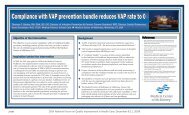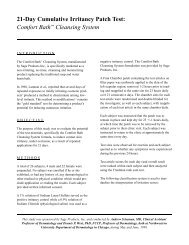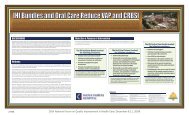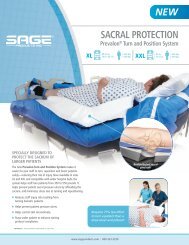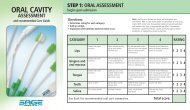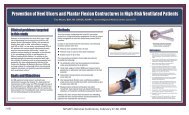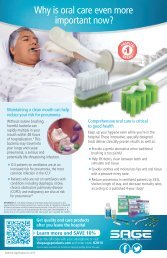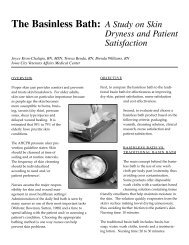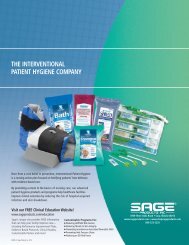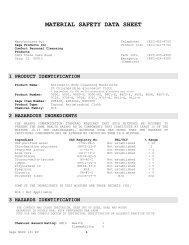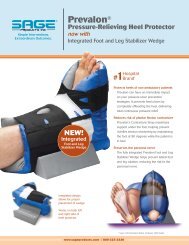Prevalon - Sage Products Inc.
Prevalon - Sage Products Inc.
Prevalon - Sage Products Inc.
You also want an ePaper? Increase the reach of your titles
YUMPU automatically turns print PDFs into web optimized ePapers that Google loves.
<strong>Prevalon</strong> <br />
Pressure-Relieving Heel Protector<br />
• Minimizes pressure, friction and shear on feet,<br />
heels and ankles of non-ambulatory patients.<br />
• Total, continuous pressure relief for at-risk heels.<br />
Open, floated-heel design completely off-loads heel<br />
from mattress. Keeps heel visible for easy monitoring<br />
between assessments.<br />
• Helps reduce the risk of foot drop. Adjustable panel<br />
delivers maximum support to the bottom of the foot.<br />
• Easy to apply and stays on patient’s foot. Stretch<br />
panels adjust in seconds for a secure, comfortable fit.<br />
And now they’re tethered to the boot for easier<br />
reapplication. No sharp edges or irritating straps that<br />
can damage skin. Ultra-soft, open-weave fabric<br />
breathes for good air circulation.<br />
• Reduces foot rotation inside the boot.<br />
Soft comfort-grip interior minimizes friction and<br />
shear, while keeping foot in proper position.<br />
• Helps maintain patient’s freedom of movement.<br />
New durable, low-friction exterior slides easily<br />
over bed sheets.<br />
• Helps keep foot in an upright position with its<br />
pontoon bottom design.<br />
• Built-in, pillow-style cushioning provides proven,<br />
familiar support surface.<br />
• Works with most deep vein thrombosis (DVT)<br />
compression devices.<br />
• Ambidextrous, universal size fits most patients.<br />
• Latex-free. Meets flammability standards.<br />
Foot and Leg Stabilizer Wedge<br />
• Helps prevent lateral foot and leg rotation,<br />
reducing pressure on the lateral side of the leg,<br />
including the peroneal nerve.<br />
• Securely attaches in seconds to the <strong>Prevalon</strong><br />
Pressure-Relieving Heel Protector.<br />
• Withstands weight and constant pressure from<br />
patient’s leg. Made with crush-resistant foam.<br />
ORDERING INFORMATION<br />
The Case For Heel Protection<br />
The High Prevalence of<br />
Heel Pressure Ulcers<br />
Of all pressure ulcers, 30.3%<br />
develop on the heel and 6.1%<br />
on the malleolus (ankle bone),<br />
the second and fifth most<br />
common sites. 1<br />
A Growing Hospital<br />
Problem<br />
“During the last five years, the<br />
incidence of hospital-acquired<br />
heel ulcers has increased from<br />
19 percent to 30 percent.” 2<br />
Patients at Risk<br />
Of the risk factors that occur in patients who develop pressure ulcers,<br />
impaired mobility is the most frequent at 87%. Over half suffer from<br />
malnutrition and decreased mental status. Other risk factors include peripheral<br />
vascular disease, diabetes mellitus, metastatic cancer, spinal cord injury, etc. 3<br />
Enormous Hospital Costs<br />
“The estimated cost per hospital stay associated with each pressure ulcer<br />
increases with the stage of the pressure ulcer.This ranges from $2,000 to<br />
$30,000 for stage 1, 2, or 3 ulcers to $70,000 for a complex, full-thickness<br />
stage 4 ulcer.” 4<br />
“Pressure ulcers (PrUs) remain a critical health care issue, with patients<br />
hospitalized in the acute care setting receiving treatment for approximately<br />
2.5 million PrUs each year. The annual cost of treating nosocomial PrUs is<br />
estimated at $2.2 to $3.6 billion.” 5<br />
AHRQ Guidelines Require Heel Intervention<br />
“Individuals in bed who are completely immobile should have a care plan<br />
that includes the use of devices that totally relieve pressure on the heels, most<br />
commonly by raising the heels off the bed. Do not use donut-type devices.<br />
(Strength of Evidence = C.)” 6<br />
Proven Results<br />
As presented at the 2006 Symposium on Advanced Wound Care (SAWC),<br />
a study featuring <strong>Prevalon</strong> found that incorporating a heel pressure ulcer<br />
prevention protocol—combined with early, aggressive implementation of<br />
pressure-reducing and pressure-relieving devices—reduces the rate of heel<br />
pressure ulcers. 7<br />
PREVALON <br />
Pressure-Relieving Heel Protector<br />
with Foot and Leg Stabilizer Wedge<br />
1 universal-size/package<br />
8 packages/case<br />
Reorder #7355<br />
PREVALON <br />
Pressure-Relieving Heel Protector<br />
1 universal-size/package<br />
8 packages/case<br />
Reorder #7300<br />
PREVALON <br />
Foot and Leg Stabilizer Wedge<br />
for use with <strong>Prevalon</strong> Heel Protector<br />
1 wedge/package<br />
10 packages/case<br />
Reorder #7350<br />
References: 1. Amlung SR, Miller WL, Bosley LM, Adv Skin Wound Care. 2001 Nov/Dec;14(6):297-301. 2. Kerstein, MD,Wounds. 2002;14(6):212-16. 3. Maklebust J, Magnan MA, Adv Wound Care. 1994 Nov;7(6):25,27-8,31-4 passim. 4.Young ZF, Evans A, Davis J, J Nurs Admin (JONA). 2003<br />
Jul/Aug;33(7/8):380-3. 5. Whittington KT, Briones R, Adv Skin Wound Care. 2004 Nov/Dec;17(9):490-4. 6. Pressure Ulcers in Adults: Prediction and Prevention. Clinical Practice Guideline No. 3, AHCPR Pub. No. 92-0047, May 1992:15-19. (Available at http://www.ahrq.gov/clinic/cpgonline.htm)<br />
Note: From summary completed by ECRI, May 1, 2001. Per a recent Evidence-based Practice Center (EPC) report commissioned by the Agency for Healthcare Research and Quality (AHRQ) (formerly AHCPR), the guideline is considered, in whole or in part, to still be current. 7. Walsh J, DeOcampo M,<br />
Waggoner D, Keeping heels intact: evaluation of a protocol for prevention of facility-acquired heel pressure ulcers. Poster presented at the Symposium on Advanced Wound Care, San Antonio,TX. April, 2006.<br />
3909 Three Oaks Road, Cary, Illinois 60013 • www.sageproducts.com • 800-323-2220<br />
20919 © <strong>Sage</strong> <strong>Products</strong> <strong>Inc</strong>. 2006<br />
patent pending



